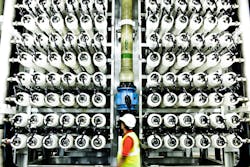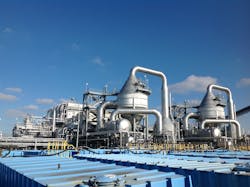Thermal Solutions for Shale Oil and Gas Water Issues
Against a weak market backdrop and a full agenda of complex issues, the world of oil and gas production has probably never seen so much uncertainty. While geopolitics have always added market volatility, other challenges are also blurring the industry outlook with heightened regulations, climate change activism, and tight labor markets.
Yet, as the sector enters the new decade, there are also opportunities. Perhaps the brightest of all is in unconventional oil and gas production, which has grown more resilient in meeting the energy needs of today at consistently lower prices. Shale drilling and oil sands extraction have become increasingly efficient and cost-competitive.
However, this wave of productivity growth seems to have missed one of the most significant operational issues: the management of water. Because the entire water process is intensive, complex, and often expensive, it is hard to explain why water is not at the top of oil producers’ minds. By not acknowledging the issues around the usage and disposal of large volumes of fresh water and produced water, some producers risk facing challenges to not only their future growth and profitability but also their environmental and safety profile, which influences much of the public's call for transparency and government regulation.
Despite many firms in the shale industry facing austerity measures and tightening capital budgets, some forward-looking producers have been seeking additional ways to become more competitive and cost-effective. One of them lies in the implementation of water recycling programs that enable growth and unlock efficiencies while boosting the social value and environmental profile of unconventional oil and gas production.
Growing Pains
Over the past few years, shale oil and gas activity has boomed in North America but not without some headaches for most producers. The inevitable flow of water associated with unconventional hydrocarbon production continues to challenge even the most sophisticated operations.
To begin with, sourcing water is becoming more problematic. The amount of water withdrawals as a percentage of the total water available is forecasted to rise substantially by 2025 amid intensifying competition between irrigation, farming, other utilities, and industrial uses. At the same time, despite heavy rains and flooding in many parts of the world, climate change has made water shortages more frequent and more acute, particularly in energy-rich areas such as Texas. IHS Markit, a technology market research provider, expects 79 percent of oil and gas activity to take place within plays facing moderate to high drought risk. Long distances to water sources, regulation around water withdrawals, and public scrutiny heighten the constraints on producers.
But a more pressing and often overlooked issue is that of produced water. Burgeoning production from unconventional sources coupled with prolonged operations from conventional but mature oil fields has created rising volumes of the inevitable by-product of oil and gas extraction: water.
On the one hand, produced water has less-than-ideal qualities. It is not only up to 10 times saltier than seawater but is also contaminated with bacteria, suspended solids, and toxic chemicals that require removal before disposal or beneficial reuse.
On the other hand, produced water volumes are staggering. It is estimated that for every barrel of oil and gas produced, four to five barrels of produced water are pumped to become the energy industry’s largest liquid waste stream. In many cases, this produced water is considered waste and is sent directly to disposal wells without consideration for reuse or recycling for other applications.
Meanwhile, to the dismay of producers, the volume of water required for hydraulic fracturing is expected to continue to increase on the heels of advances in drilling techniques, with longer wells necessary to stimulate harder-to-reach reservoirs in search of higher yields. Water cuts or water-to-oil ratios can be as high as 15-to-1 in western Texas, a region known for the most prolific shale oil play in America: the Permian Basin. Here, horizontal drilling, fracturing, and pressure-maintaining flooding techniques can only use a fraction of this produced water. The excess is injected in remote, often distant disposal wells that reach capacity more quickly, taking brine-hauling operations further and making them more expensive.
Trucking and disposing of water through reinjection, which might seem the most cost-effective option today, is not sustainable, particularly in areas of the oil patch with very tight labor markets and less-developed transfer systems. Geological limitations have raised further concern, driving regulations to prevent contamination of drinking water sources and seismic activity around disposal wells. In view of these trends, localized water management solutions are more adequate in the long term from both an economic and environmental perspective.
Rough Waters
Given the central role of water-related expenses representing around 50 percent of exploration and production (E&P) operating costs, controlling water management spending is a crucial step for producers in a low oil price environment. To this end, the implementation of water recycling technologies solves the need to reduce both freshwater withdrawals and produced water disposal. With increased adoption and improved economics, it is expected that recycling and reuse programs will double their share of the water management market from 10 to 20 percent in the next five years. However, water reuse will only rise up to the need to meet frack water demand. Because hydraulic fracturing produces up to five times more water than it needs for reuse, the recycling of water outside the fence is an opportunity to reduce risk and create value for industries, farmers, and communities.
At first, water reuse involves relatively inexpensive treatment technologies to target the removal of particulates such as fine solids and bacteria, as well as organics such as dispersed oil. Both are typically removed by filtration, flotation, or membrane separation. Further downstream, scale formers such as iron, barium, strontium, or calcium are typically removed by chemical precipitation or ion-exchange softening, a technique that selectively replaces hardness ions. The last barrier to recycling produced water beyond the limits of oilfield needs lies in the reduction or removal of dissolved solids.
Drilling for Cost-Effective Water Solutions
Because of their major importance in the overall investment, desalination technologies require a careful analysis of upfront capital costs (CapEx) and operational costs (OpEx) necessary to keep the plant running once it is online. OpEx typically includes the energy, chemicals, labor, operational replacement parts, and disposal of waste streams.
Membrane systems have lower operating costs and often lower capital costs. The capital tradeoff is the pretreatment step required to protect the membranes and avoid fouling and subsequent chemical cleaning, which impacts performance and operation. Often, these pretreatment steps can involve multiple unit operations and can significantly increase the membrane capital cost. When totaled, the CapEx of a membrane system can equal a thermal system.
On the other hand, centralized plants using evaporative systems such as advanced brine concentrators and crystallizers are more energy intensive, but they are also more robust and reliable because they can be used on any kind of high-salinity feedwater and can deliver higher water recoveries compared to membranes, including zero liquid discharge (ZLD) if necessary.
Although thermal technologies have higher capital and operating costs, large-scale treatment needs can be made more economical because of the efficiencies in heat recovery which reduce energy costs. In doing so, evaporative systems are categorized into two types depending on the way they handle the vapors generated. Highly efficient mechanically driven systems recompress vapor using it to drive additional evaporation by electrical means. In contrast, thermal-driven systems use high-pressure steam to recycle vapor and drive additional evaporation. This is normally done in multi-effect mode where the vapor created in one evaporator is used to drive additional evaporation in the next “effect.” Thus, the amount of source steam can be reduced by adding effects. Thanks to evolving compression technology, next generation systems will achieve further reductions in energy costs and emissions.
In the end, the efficiency of membrane-based and thermal-based solutions are limited by osmotic pressure and thermodynamics, respectively, as the need for increased amounts of energy results in diminishing returns to remove water from a brine with rising salt concentration.
But in the context of increasing logistical challenges, thermal concentration systems can concentrate brine higher and thus produce a lower volume of a heavy saturated brine. The follow-on is minimal transportation and disposal costs. Implemented through either mechanical recompression or multi-stage evaporation, thermal systems often achieve 70 to 90 percent water recovery. When crystallizers are incorporated to concentrate solutions beyond salt saturation levels, the operation precipitates dry solids reaching zero-liquid discharge with water recoveries nearing 100 percent.
In contrast, if freshwater sourcing is limited and waste minimization is not as important as delivering a water stream of suitable quality for reuse, then a membrane technology with lower recoveries may be more appropriate.
Hybrid alternatives are often evaluated, integrating membrane-based solutions followed by thermal evaporation and crystallization systems. These systems capitalize on the ability of membranes to reduce produced water volume at a lower cost while decreasing the size of thermal concentration systems downstream.
Balancing Diverse Priorities
Producers face difficult choices to maintain competitiveness. Delivering short-term results while hitting long-term goals has always been a juggling act. It is all the more difficult with renewed calls for capital discipline amid lower and more volatile markets. But implementing water management strategies with large impact in the long run requires bold choices. They are going to define the future of those that will unlock value and reduce risk to survive and be able to grasp new opportunities.
Against a landscape of shifting demand toward cheaper and cleaner energy sources, recycling water technology delivers value on three key industry frontiers:
- Standardization uses proven processes and systems that, because of their level of maturity, give producers standard, modularized systems at a lower cost.
- Digitalization and cloud-based digital platforms promote oil producer–water technology supplier collaboration and optimize assets and production with lower operational expenditures.
- Decarbonization enabled by the removal of trucks from the road helps producers increase a stakeholder’s acceptance and become more resilient and more competitive.
Producers have made remarkable achievements since the beginning of the shale energy revolution. As the industry matures with stronger players, they must continue this wave of innovation to secure a future with more predictability. Only those players that can lower freshwater usage and disposal costs through better management and technologies will be better positioned to compete today and for decades to come. Although advanced thermal technologies for water recycling are a significant investment, the cost of doing nothing can be much higher. WT
About the Authors
Matias Navarro is a marketing specialist and new market developer. Through his international work in the infrastructure, environment, and cleantech sectors, he brings in-depth research focused on improving the competitive positioning, market strategy, and growth opportunities with Veolia Water Technologies.
Mark Nicholson is a senior project developer with Veolia Water Technologies. He has worked in the water industry for over two decades focused on evaporation, crystallization, and zero-liquid discharge systems. He has designed multiple thermal separation systems with a primary emphasis on the power and oil and gas industries. Mark authored numerous papers on water reuse and recycling and holds U.S. and Canadian patents.
About the Author
Matias Navarro
Matias Navarro is a marketing specialist and new market developer. Through his international work in the infrastructure, environment, and cleantech sectors, he brings in-depth research focused on improving the competitive positioning, market strategy, and growth opportunities with Veolia Water Technologies.
Mark Nicholson
Mark Nicholson is a senior project developer with Veolia Water Technologies. He has worked in the water industry for over two decades focused on evaporation, crystallization, and zero-liquid discharge systems. He has designed multiple thermal separation systems with a primary emphasis on the power and oil and gas industries. Mark authored numerous papers on water reuse and recycling and holds U.S. and Canadian patents.


